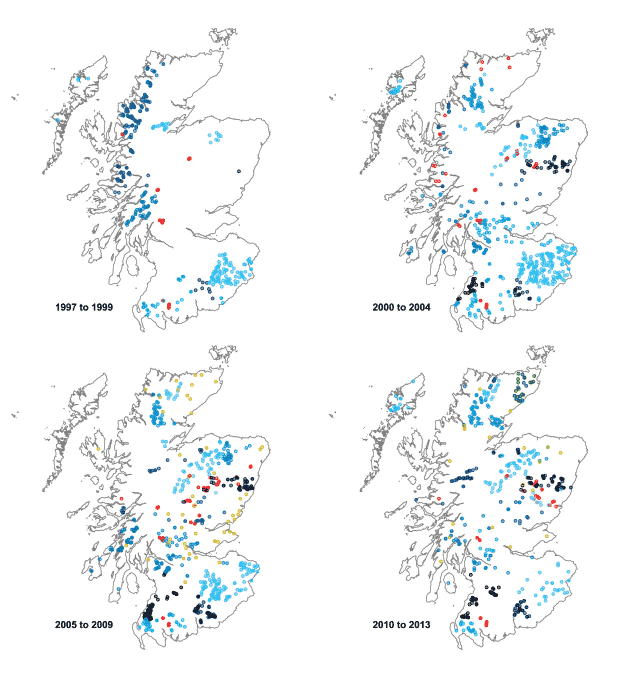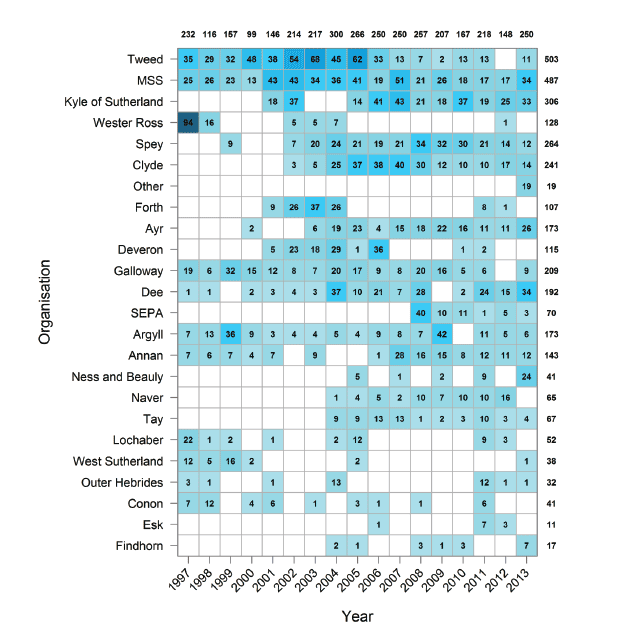Scottish Marine and Freshwater Science Vol 6 No 6: Development of a Model for Predicting Large Scale Spatio-Temporal Variability in Juvenile Fish Abundance from Electrofishing Data
Models of juvenile salmonid abundance are required to inform electrofishing based assessment approaches and potentially as an intermediate step in scaling conservation limits from data rich to data poor catchments. This report describes an approach for mo
Data Availability
Given variability in catch efficiency (Borgstrom and Skaala, 1993; Niemela et al., 2000), only multi-pass data were collated for this report. Data was obtained from the Scottish Fisheries Coordination Centre ( SFCC) database, Marine Scotland Science ( MSS) FishObs database and in spreadsheet format from Scottish Environment Protection Agency ( SEPA) and Caithness District Salmon Fishery Board (Alan Youngson). Additional MSS data were compiled in spreadsheet formats where not already entered on the FishObs database. Sites that were known to be stocked (as identified by the SFCC stocking code or knowledge of MSS staff) were excluded to simplify modelling requirements. Because many data sources do not reliably obtain ages from scale reading, electrofishing data was resolved to life-stage (fry or parr) rather than individual age class. Throughout this report 'Site' is used to define a location visited for electrofishing; 'Site Visit' identifies individual visits to a Site. The starting dataset contained 2511 sites and 5468 site visits. Only those data collected between 1997 and 2013 and between the 1st June and 21st November were used in subsequent analyses (2367 sites, 4748 site visits) because few of the collated data lay outside of these time periods and thus there was insufficient information to inform large scale spatio-temporal models. The compiled data was also visually assessed in relation to covariates and outliers removed leaving 2353 sites and 4648 site visits. Because preliminary model fits suggested implausible relationships between fish density and high values of the covariates "Channel Width" and "Upstream Catchment Area", a manual check of raw data was performed on site visits with a width of >25m and an upstream catchment area of >500km2. This check suggested a number of circumstances where only partial electrofishing surveys ( e.g. peripheral areas or single channels in braided rivers) were carried out on larger rivers. Given the potential bias of these data (28 Site visits to 27 sites) they were also excluded from the analysis. Finally, any sites located above impassable barriers were removed from the dataset, so that the final dataset only contained locations that were accessible to salmon, reducing the final dataset to 3743 site visits from 1875 sites.
The spatial and temporal coverage of multi-pass electrofishing data in the final dataset is shown in Figure 1. In general, spatial coverage increased between 1997 and 2013, the exception being North West Scotland, where data coverage was better in earlier years. There was a general paucity of data from the islands, with no data available from Orkney or Shetland. A schematic showing the temporal variability in the number of site visits provided by each Organisation is shown in Figure 2.
Figure 1 Spatial and temporal data coverage (un-stocked sites with multi-pass electrofishing, below impassable barriers) between 1997 and 2013. Prior to 1997 there are too few data from too constrained an area for useful large scale model fitting. Data are colour coded by source: MSS (red), SEPA (yellow), Other (green), SFCC (each trust is represented by a different shade of blue).
Figure 2 Schematic showing the temporal coverage of data by provider. Organisations are ordered by the mean annual number of site visits. Total site visits by Year and by Organisation are given in the margins.
Contact
There is a problem
Thanks for your feedback

